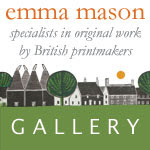Steve Speller, photographer and Alison Milner, designer moved into their five bedroomed Victorian terrace house on the seafront in Worthing ten years ago with their two children who were then four and six. They work together and also in their own right. Alison has recently been selected for Reflect Forward she will be making new work based on the Wellcome Trust Collection.
 Outside of house and front garden. They noticed the furniture abandoned next to a fishing boat on the beach and asked the fisherman if they could have it.
Outside of house and front garden. They noticed the furniture abandoned next to a fishing boat on the beach and asked the fisherman if they could have it.As soon as Steve and Alison looked around the house they had to have it, despite not really having made the decision to move to Worthing. The two factors that decided them were; firstly the amazing view which stretches from Newhaven to Worthing Pier and secondly the huge amount of space they would have compared to their much smaller terrace house in Bow, East London. The down side was that there were plastic windows and no garden. They grew to appreciate the windows! and dug up the paving stones at the front and bought a few hundred weights of soil which they planted with hardy seaside plants. The house had formerly been part of a guest house for retired milkmen. The décor was very institutional with loads of magnolia woodchip wallpaper, firedoors painted brown, no smoking signs and safety rails. They have done loads of work on the house but parts of it still prompt people to ask if they have just moved in. The best thing they did was make the whole of downstairs into one interconnecting space.
 Living room: prints by Sarah Young and Jenny Newson, ceramics by Kate Malone and Arwyn Jones, tiles by Christiane and Alison, folding chair from Portobello Road (£12 in 1982) and utility chair from a skip in London.
Living room: prints by Sarah Young and Jenny Newson, ceramics by Kate Malone and Arwyn Jones, tiles by Christiane and Alison, folding chair from Portobello Road (£12 in 1982) and utility chair from a skip in London. Wire basket by Jemma Lumber who Alison taught at Northbrook, stones and leaves found on walks get deposited in it.
Wire basket by Jemma Lumber who Alison taught at Northbrook, stones and leaves found on walks get deposited in it. Hanging grass animals from Delhi Craft Museum, Lampshade made from plastic cups, clocks from a Worthing skip, sofa from Islington junk shop (£50 in 1986) chairs from ikea.
Hanging grass animals from Delhi Craft Museum, Lampshade made from plastic cups, clocks from a Worthing skip, sofa from Islington junk shop (£50 in 1986) chairs from ikea. Kitchen reclaimed slate surface from Shoreham cement works, table by Simon Pengelly from Habitat, Bent wood chairs from a Conservative club in London made in Estonia in the 1940s. Crystalline glaze fruit bowl by Gordon Murdoch.
Kitchen reclaimed slate surface from Shoreham cement works, table by Simon Pengelly from Habitat, Bent wood chairs from a Conservative club in London made in Estonia in the 1940s. Crystalline glaze fruit bowl by Gordon Murdoch. Alison took loads of photographic details around the house in preparation for this blog and this accidental but passionate meeting of a sponge and a soap dish was her favourite.
Alison took loads of photographic details around the house in preparation for this blog and this accidental but passionate meeting of a sponge and a soap dish was her favourite. Alison has always collected bones since she was a little girl. A seagull left a dead pigeon on their roof terrace and within a few days it was reduced to this by the crows … it looks a bit like a cartoon character… Its in a part of their house not seen by the casual visitor! The Eskimo was one of Steve’s favorite toys when he was a child and has lost it’s face.
Alison has always collected bones since she was a little girl. A seagull left a dead pigeon on their roof terrace and within a few days it was reduced to this by the crows … it looks a bit like a cartoon character… Its in a part of their house not seen by the casual visitor! The Eskimo was one of Steve’s favorite toys when he was a child and has lost it’s face.Alison will be showing Ceramics made in collaboration with Christiane Kersten at Made08.
See Alison and Steve’s website to see the wide variety of work they are involved with.
Click Here to Read More..



















































